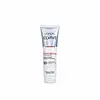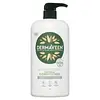What's inside
What's inside
 Key Ingredients
Key Ingredients

 Benefits
Benefits

 Concerns
Concerns

 Ingredients Side-by-side
Ingredients Side-by-side

Water
Skin ConditioningCetearyl Alcohol
EmollientGlycerin
HumectantBehentrimonium Chloride
PreservativeDimethicone
EmollientBis-Cetearyl Amodimethicone
Cetyl Esters
EmollientSodium Citrate
BufferingCitric Acid
BufferingIsopropyl Alcohol
SolventDicetyldimonium Chloride
EmulsifyingCoco-Betaine
CleansingHydroxypropyl Guar
Emulsion StabilisingSodium Chloride
MaskingHydroxycitronellal
PerfumingPhenoxyethanol
PreservativeSteareth-6
EmulsifyingAcetic Acid
BufferingPEG-100 Stearate
Trideceth-10
CleansingTrideceth-3
EmulsifyingTrisodium Hedta
Limonene
PerfumingCandelilla Cera
EmollientLinalool
PerfumingIsopropyl Myristate
EmollientAmodimethicone
Cetrimonium Chloride
AntimicrobialHexyl Cinnamal
PerfumingParfum
MaskingWater, Cetearyl Alcohol, Glycerin, Behentrimonium Chloride, Dimethicone, Bis-Cetearyl Amodimethicone, Cetyl Esters, Sodium Citrate, Citric Acid, Isopropyl Alcohol, Dicetyldimonium Chloride, Coco-Betaine, Hydroxypropyl Guar, Sodium Chloride, Hydroxycitronellal, Phenoxyethanol, Steareth-6, Acetic Acid, PEG-100 Stearate, Trideceth-10, Trideceth-3, Trisodium Hedta, Limonene, Candelilla Cera, Linalool, Isopropyl Myristate, Amodimethicone, Cetrimonium Chloride, Hexyl Cinnamal, Parfum
Water
Skin ConditioningCetearyl Alcohol
EmollientCyclotetrasiloxane
EmollientAvena Sativa Kernel Flour
AbrasiveDimethicone
EmollientCetrimonium Chloride
AntimicrobialHydroxyethylcellulose
Emulsion StabilisingPhenoxyethanol
PreservativeCaprylyl Glycol
EmollientBehentrimonium Methosulfate
Lauryl Pyrrolidone
CleansingAmodimethicone
Sodium PCA
HumectantPanthenol
Skin ConditioningCyclopentasiloxane
EmollientCocodimonium Hydroxypropyl Hydrolyzed Wheat Protein
CleansingAloe Barbadensis Leaf Juice
Skin ConditioningSorbic Acid
PreservativeTrideceth-12
EmulsifyingWater, Cetearyl Alcohol, Cyclotetrasiloxane, Avena Sativa Kernel Flour, Dimethicone, Cetrimonium Chloride, Hydroxyethylcellulose, Phenoxyethanol, Caprylyl Glycol, Behentrimonium Methosulfate, Lauryl Pyrrolidone, Amodimethicone, Sodium PCA, Panthenol, Cyclopentasiloxane, Cocodimonium Hydroxypropyl Hydrolyzed Wheat Protein, Aloe Barbadensis Leaf Juice, Sorbic Acid, Trideceth-12
Ingredients Explained
These ingredients are found in both products.
Ingredients higher up in an ingredient list are typically present in a larger amount.
This water-soluble silicone is used for its hydrating and softening properties. It is used to add a silky feel to skincare products and has great benefits for haircare.
In haircare, this ingredient:
- Adds shine
- Protects color
- Offers thermal protection
- Boosts hair strength
- Does not build up as easily
Cetearyl alcohol is a mixture of two fatty alcohols: cetyl alcohol and stearyl alcohol. It is mainly used as an emulsifier. Emulsifiers help prevent the separation of oils and products. Due to its composition, it can also be used to thicken a product or help create foam.
Cetearyl alcohol is an emollient. Emollients help soothe and hydrate the skin by trapping moisture.
Studies show Cetearyl alcohol is non-toxic and non-irritating. The FDA allows products labeled "alcohol-free" to have fatty alcohols.
This ingredient is usually derived from plant oils such as palm, vegetable, or coconut oils. There is debate on whether this ingredient will cause acne.
Due to the fatty acid base, this ingredient may not be Malassezia folliculitis safe.
Learn more about Cetearyl AlcoholThis ingredient is a preservative, antimicrobial, and emulsifier. It is often used in cosmetics for its ability to cleanse, condition, and reduce static.
Cetrimonium chloride is a quaternary ammonium salt, meaning it has a water-soluble structure.
Dimethicone is a type of synthetic silicone created from natural materials such as quartz.
What it does:
Dimethicone comes in different viscosities:
Depending on the viscosity, dimethicone has different properties.
Ingredients lists don't always show which type is used, so we recommend reaching out to the brand if you have questions about the viscosity.
This ingredient is unlikely to cause irritation because it does not get absorbed into skin. However, people with silicone allergies should be careful about using this ingredient.
Note: Dimethicone may contribute to pilling. This is because it is not oil or water soluble, so pilling may occur when layered with products. When mixed with heavy oils in a formula, the outcome is also quite greasy.
Learn more about DimethiconePhenoxyethanol is a preservative that has germicide, antimicrobial, and aromatic properties. Studies show that phenoxyethanol can prevent microbial growth. By itself, it has a scent that is similar to that of a rose.
It's often used in formulations along with Caprylyl Glycol to preserve the shelf life of products.
Water. It's the most common cosmetic ingredient of all. You'll usually see it at the top of ingredient lists, meaning that it makes up the largest part of the product.
So why is it so popular? Water most often acts as a solvent - this means that it helps dissolve other ingredients into the formulation.
You'll also recognize water as that liquid we all need to stay alive. If you see this, drink a glass of water. Stay hydrated!
Learn more about Water